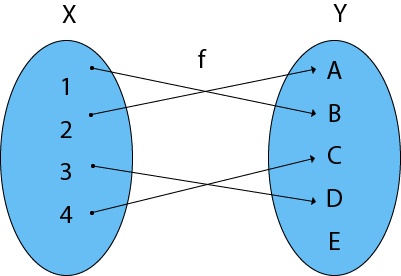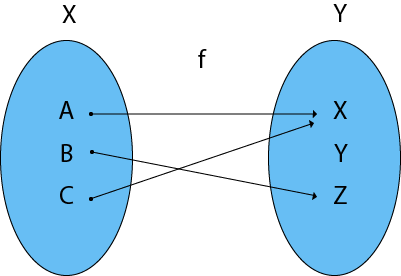It is a mapping in which every element of set A is uniquely associated at the element with set B. The set of A is called Domain of a function and set of B is called Co domain.

Domain, Co-Domain, and Range of a Function:
Domain of a Function: Let f be a function from P to Q. The set P is called the domain of the function f.
Co-Domain of a Function: Let f be a function from P to Q. The set Q is called Co-domain of the function f.
Range of a Function: The range of a function is the set of picture of its domain. In other words, we can say it is a subset of its co-domain. It is denoted as f (domain).
If f: P → Q, then f (P) = {f(x): x ∈ P} = {y: y ∈ Q | ∃ x ∈ P, such that f (x) = y}.Example: Find the Domain, Co-Domain, and Range of function.
Let x = {1, 2, 3, 4}y = {a, b, c, d, e}
f = {(1, b), (2, a), (3, d), (4, c)

Solution:
Domain of function: {1, 2, 3, 4}
Range of function: {a, b, c, d}
Co-Domain of function: {a, b, c, d, e}Functions as a Set
If P and Q are two non-empty sets, then a function f from P to Q is a subset of P x Q, with two important restrictions
- ∀ a ∈ P, (a, b) ∈ f for some b ∈ Q
- If (a, b) ∈ f and (a, c) ∈ f then b = c.
Note1: There may be some elements of the Q which are not related to any element of set P.
2. Every element of P must be related with at least one element of Q.
Example1: If a set A has n elements, how many functions are there from A to A?
Solution: If a set A has n elements, then there are nn functions from A to A.
Representation of a Function
The two sets P and Q are represented by two circles. The function f: P → Q is represented by a collection of arrows joining the points which represent the elements of P and corresponds elements of Q
Example1:
Let X = {a, b, c} and Y = {x, y, z} and f: X → Y such that
f= {(a, x), (b, z), (c, x)}
Then f can be represented diagrammatically as follows

Example2: Let X = {x, y, z, k} and Y = {1, 2, 3, 4}. Determine which of the following functions. Give reasons if it is not. Find range if it is a function.
- f = {(x, 1), (y, 2), (z, 3), (k, 4)
- g = {(x, 1), (y, 1), (k, 4)
- h = {(x, 1), (x, 2), (x, 3), (x, 4)
- l = {(x, 1), (y, 1), (z, 1), (k, 1)}
- d = {(x, 1), (y, 2), (y, 3), (z, 4), (z, 4)}.
Solution:
- It is a function. Range (f) = {1, 2, 3, 4}
- It is not a function because every element of X does not relate with some element of Y i.e., Z is not related with any element of Y.
- h is not a function because h (x) = {1, 2, 3, 4} i.e., element x has more than one image in set Y.
- d is not a function because d (y) = {2, 3} i.e., element y has more than image in set Y.




No comments:
Post a Comment